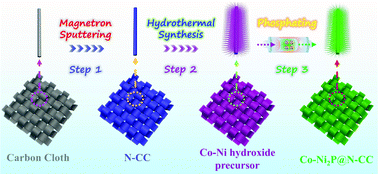A 3D free-standing Co doped Ni2P nanowire oxygen electrode for stable and long-life lithium–oxygen batteries†
Abstract
Exploring oxygen electrodes with superior bifunctional catalytic activity and suitable architecture is an effective strategy to improve the performance of lithium–oxygen (Li–O2) batteries. Herein, the internal electronic structure of Ni2P is regulated by heteroatom Co doping to improve its catalytic activity for oxygen redox reactions. Meanwhile, magnetron sputtering N-doped carbon cloth (N-CC) is used as a scaffold to enhance the electrical conductivity. The deliberately designed Co-Ni2P on N-CC (Co-Ni2P@N-CC) with a typical 3D interconnected architecture facilitates the formation of abundant solid–liquid–gas three-phase reaction interfaces inside the architecture. Furthermore, the rational catalyst/substrate interfacial interaction is capable of inducing a solvation-mediated pathway to form toroidal-Li2O2. The results show that the Co-Ni2P@N-CC based Li–O2 battery exhibits an ultra-low overpotential (0.73 V), enhanced rate performance (4487 mA h g−1 at 500 mA g−1) and durability (stable operation over 671 h). The pouch-type battery based on the Co-Ni2P@N-CC flexible electrode runs stably for 581 min in air without obvious voltage attenuation. This work verifies that heterogeneous atom doping and interface interaction can remarkably strengthen the performance of Li–O2 cells and thus pave new avenues towards developing high-performance metal–air batteries.



 Please wait while we load your content...
Please wait while we load your content...